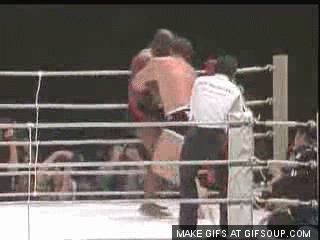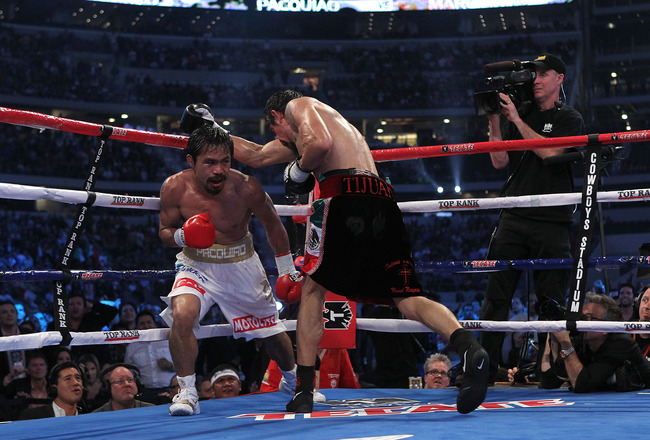Hey folks,
Still technically on hiatus, but wanted to move this over here because HeadKickLegend, my former writing spot, has closed it's doors. While I'm moving on to BloodyElbow, a much bigger site, next week, I will not be allowed to use gifs there and shall therefore be unable to continue this series.
I quite enjoyed writing this one, and I don't think any MMA journalists have broken down Dos Santos in the detail that I began to in this piece.
This piece was written during the period when Overeem was still Dos Santos' prospective opponent, but the technical aspects are still relevant. Junior's body straights were visible in full force in his demolition of Frank Mir the other night.
Hope to get back to writing within in the week!
Cheers,
Jack This article is part of a series of articles detailing the striking techniques of UFC Heavyweight Champion, Junior Dos Santos. All of these, and over 70 techniques by 19 other fighters, are broken down in detailed demonstration in Jack Slack's new book Advanced Striking: Tactics of Kickboxing, Boxing and MMA Masters, which is out NOW!Junior Dos Santos and the Right Body Straight
This article is part of a series of articles detailing the striking techniques of UFC Heavyweight Champion, Junior Dos Santos. All of these, and over 70 techniques by 19 other fighters, are broken down in detailed demonstration in Jack Slack's new book Advanced Striking: Tactics of Kickboxing, Boxing and MMA Masters, which is out NOW!Junior Dos Santos and the Right Body StraightWhen Junior dos Santos knocked Cain Velasquez out in under two minutes with a sloppy overhand at the first UFC event on Fox, it seemed as though the most ridiculous boxing elitists had been proven right. A competent boxer was able to show all the heavyweight "Ultimate Fighters" what for, using few other skills. The success of Dos Santos has not been a flash in the pan, he is the most entertaining heavyweight champion in some time, and far more battle tested than Brock Lesnar or Cain Velasquez. What has not been examined anywhere else, is the cause of Dos Santos' success. Herein we shall dissect the style of Cigano, and not simply proclaim him to be "too fast", "too strong", or "unstoppable".
Several key areas of Junior Dos Santos' mixed martial arts game will be examined through this series. The first is his right straight, which he uses both as a lead and counter, to the head and to the body. The second is his use of clubbing hooks. And then we shall turn our attention to his jab, or lack thereof, his approach to the clinch, and the chinks in his formidable armor.
One of the key features of Junior Dos Santos' game is his right straight. Due to his carrying his lead hand low (for reasons to be expanded upon later), Junior's jab often lacks authority, serving more as a flicking distraction when setting up a power punch. As his jab lacks the authoritative force of a more orthodox style puncher, such as a BJ Penn, Cigano is forced to use his right hand to throw his power straights. This can be seen to ample extent in all of his fights.
Dos Santos uses the right body straight in one of two ways:
- As an offense to set up his overhand.
- As a counter punch to set up his left hook.
As a LeadOf the 7 significant strikes that Dos Santos scored in his fight with Cain Velasquez, two were powerful right straights to the body, and one was a probing jab to the solar plexus and one was a front kick to the midsection. This simple attacking of Velasquez's left floating rib with Dos Santos' right straight was enough to draw the inexperienced Velasquez's hand out of position. Having crouched and ducked his head twice for a right straight to the body, the third time Dos Santos dropped his weight, he was able to connect a swinging right over the top of Velasquez's lowered defense. It was far from a pefect punch, in fact it was technically hideous - connecting with the thumb and little else, at the end of a fully extended arm - but the set up was world class.

Dos Santos does not often use hooks to the body, and is known somewhat as a headhunter, but his right straight to the body is an excellent way to draw opponents out of position. Arguably the hardest hitter in the heavyweight division, it will be hard for any heavyweight to ignore Dos Santos pot shotting their midriff. Furthermore, Dos Santos' head movement toward the opponent's right hand as he throws the right straight baits the opponent in to throwing a punch of his own. Notice in the above picture, of the right straight to the body that Dos Santos throws immediately before the knockout overhand, that Cain is punching to where he feels Dos Santos' head will be. This led to Dos Santos' overhand looping over the extending arm of Velasquez and landing in a "Cross Counter", assuring the knockout.

 As a Counter
As a CounterDos Santos has also had great success with the right body straight as a counter, which was particularly visible in his destruction of Muay Thai veteran, Gilbert Yvel. As Yvel jabbed at Cigano, the latter ducked to his left and threw a right straight to Yvel's midsection. This action clearly affected Gilbert as his hands came out of position and he stood bolt upright as he followed his initial 1 - 2 with a left hook. Dos Santos, escaping the first half of the exchange untouched, exploded up out of the crouch that he had taken and decked the Dutchman.

While Yvel has never had a strong jawline, he is used to being hit hard by big men and has recovered well in the past, when he hits the ground against Dos Santos Yvel seems as winded by the body blow as he is stunned by the trauma that his cranium has just experienced. His hands keep moving right up until the stoppage but he seems to have trouble rising, which leaves him in the path of perhaps the most savage left hook I have ever seen a fighter deliver from his knees.
It should be noted that fighters do not react to body blows as they do in the movies, bending over when hurt. The discipline to stay upright has been pounded into them since day one and this often means that following a winding body shot they will stand straight up, but their hands will sag below their jaw. This is another reason that the left hook to the head works so well when following the right straight to the body.
The right body straight as a counter is rare to see in boxing nowadays. It is confined almost entirely to Karate competition, where it's setting up of the left hook is completely useless. When carnival boxer and hilarious braggart, J. C. "Champ" Thomas described the counter in his book "How to be an Ass-whipping Boxer" as far back as the 1970s, it was still against the grain of what constituted good boxing. This may be to do with the perceived lack of power that the body straight has when compared to a right hook to the body, or do to the fear of dropping one's weight towards the opponent's power hand.

Whatever the reason modern boxing has largely forgotten the right straight counter to the body, it sets up the left hook counter beautifully, and Dos Santos certainly gets enough power in it to make his opponents forget where their hands should be against such a very dangerous man.
Want to learn the techniques of Junior Dos Santos? These, and the techniques of 20 other elite strikers, are broken down in detailed photography in Jack Slack's new book Advanced Striking: Tactics of Kickboxing, Boxing and MMA Masters, which is out NOW!

















